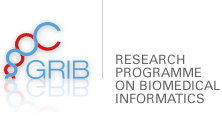
28/11/2016
A protein that defines the melanoma blueprint
Identified a new factor essential for the development of these aggressive tumours. This protein helps to define aspects that distinguish melanoma from other types of cancer
(Madrid, 18 November, 2016; CNIO Publications at CNIO website)
The main goals of the Melanoma Group at the Spanish National Cancer Research Centre (CNIO) are to identify biomarkers of tumour progression and to validate novel therapeutic targets in melanoma. In particular, their research focuses on discovering features that define the "fingerprint" of this tumour, features that distinguish it from other cancer types. The latest study in this area, published in Nature Communications, describes the roles of CPEB4; a protein that is crucial for melanoma cell survival.
Melanomas are particularly aggressive and finding mechanisms that drive this behaviour has been complicated due to the unexpectedly high mutation rate associated with this malignancy. The group headed by Marisol Soengas, senior author of this paper, is an expert in researching the "identity" of melanomas.
"In previous studies, we have demonstrated that melanomas are very different from other types of tumours in that they activate mechanisms of self-degradation (autophagy), or control the internalization and secretion of molecules, for example," explains Soengas. They have now found that the CPEB4 protein, which is of great interest in the cancer field, plays a selective and essential role in melanoma cells.
In broad terms, CPEBs are involved in the regulation of gene expression and are associated with important cellular processes, such as cell division, cell differentiation, or cell polarity and migration. In tumours, the expression of CPEBs varies, and seemingly opposing, pro- and anti-tumour, roles have been described in other tumour types but not in melanoma.
CPEB4, a member of this family, was "especially attractive" to the authors "given its overexpression in tumours such as gliomas and pancreatic carcinomas, which are also aggressive". As they noted, the levels of this protein were very high in melanoma from the early stages of the disease, which made the researchers suspect its association with cell proliferation. What they did not know was the extent of it.
Soengas' group compared the effects of CEPB4 on various tumours, and noted that melanoma cells were "more dependent on this protein", since its inhibition greatly hindered the proliferation of these cells. This 'addiction' makes melanoma more vulnerable to drugs targeting this pathway, and can be a novel target for therapeutic intervention in melanoma.
The researchers also describe that melanomas depend so tightly on CPEB4 because this protein regulates the expression of factors such as MITF and RAB27A, which have unique functions in this tumour type. CPEB4, is therefore a main driver of the "intrinsic signature" that separates melanomas from other pathologies, concludes Soengas.
This paper has been funded by Marató TVE, Consolider RNAREG (Spanish Ministry of Economy and Competitiveness), Fundación Botín and Banco Santander, Spanish Ministry of Health, Fundación Sandra Ibarra, Ludwig Institute for Cancer Research, Fundación 'la Caixa', Asociación Española Contra el Cáncer (AECC) and Fundación Mutua Madrileña.
Reference article:
Lineage-specific roles of the cytoplasmic polyadenylation factor CPEB4 in the regulation of oncogenic drivers in melanoma. Eva Pérez-Guijarro, Panagiotis Karras, Metehan Cifdaloz, Raúl Martínez-Herranz, Estela Cañón, Osvaldo Graña, Celia Horcajada, Direna Alonso-Curbelo, Tonantzin G. Calvo, Gonzalo Gomez, Nicolas Bellora, Erica Riveiro-Falkenbach, Pablo Otiz-Romero, José Luis Rodríguez-Peralto, Lorena Maestre, Giovanna Roncador, Juan C de Agustín Asensio, Colin R. Goding, Eduardo Eyras, Diego Megías, Raúl Méndez and María S. Soengas. Nature Communications (2016). DOI: http://dx.doi.org/10.1038/NCOMMS13418



